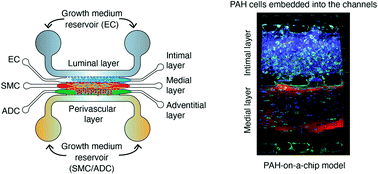Pulmonary-arterial-hypertension (PAH)-on-a-chip: fabrication, validation and application†
Abstract
Currently used animal and cellular models for pulmonary arterial hypertension (PAH) only partially recapitulate its pathophysiology in humans and are thus inadequate in reproducing the hallmarks of the disease, inconsistent in portraying the sex-disparity, and unyielding to combinatorial study designs. Here we sought to deploy the ingenuity of microengineering in developing and validating a tissue chip model for human PAH. We designed and fabricated a microfluidic device to emulate the luminal, intimal, medial, adventitial, and perivascular layers of a pulmonary artery. By growing three types of pulmonary arterial cells (PACs)-endothelial, smooth muscle, and adventitial cells, we recreated the PAH pathophysiology on the device. Diseased (PAH) PACs, when grown on the chips, moved of out their designated layers and created phenomena similar to the major pathologies of human PAH: intimal thickening, muscularization, and arterial remodeling and show an endothelial to mesenchymal transition. Flow-induced stress caused control cells, grown on the chips, to undergo morphological changes and elicit arterial remodeling. Our data also suggest that the newly developed chips can be used to elucidate the sex disparity in PAH and to study the therapeutic efficacy of existing and investigational anti-PAH drugs. We believe this miniaturized device can be deployed for testing various prevailing and new hypotheses regarding the pathobiology and drug therapy in human PAH.



 Please wait while we load your content...
Please wait while we load your content...